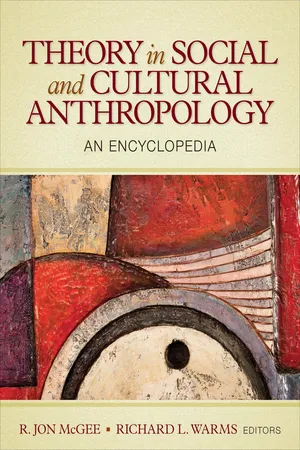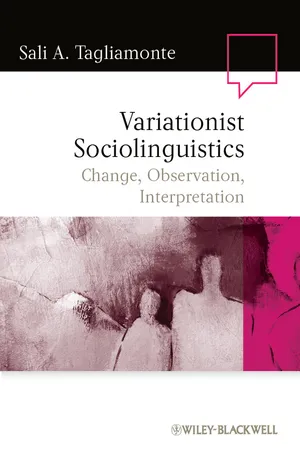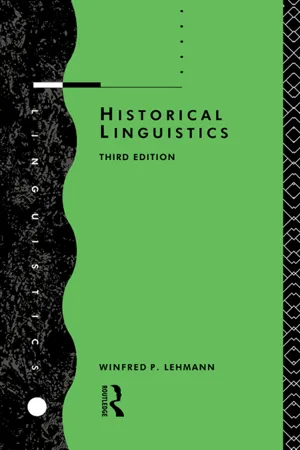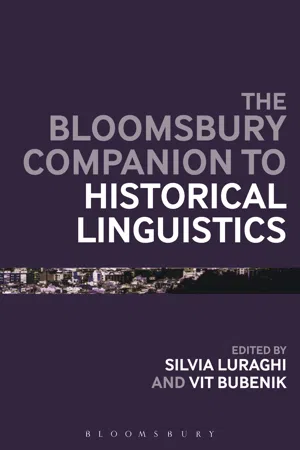Comparison
Comparison in linguistics refers to the process of identifying similarities and differences between languages or linguistic elements. It involves analyzing various linguistic features such as phonology, morphology, syntax, and semantics to understand how languages are similar or different. Comparisons can help linguists uncover patterns, relationships, and typological characteristics across different languages.
5 Key excerpts on "Comparison"
- eBook - ePub
Theory in Social and Cultural Anthropology
An Encyclopedia
- R. Jon McGee, Richard L. Warms(Authors)
- 2013(Publication Date)
- SAGE Publications, Inc(Publisher)
...Cecil H. Brown Cecil H. Brown Comparative Linguistics Comparative linguistics 129 133 Comparative Linguistics Approximately, 6,000 languages are currently spoken. One approach to studying them is to compare them for similarities and differences. This can yield insights into the history of the people who speak the languages and into the nature of the human language faculty. Linguists recognize three major structural components of language: (1) phonology (the sounds of language), (2) grammar (the formation of words from sounds and sentences from words), and (3) lexicon/semantics (words and their meanings). Some languages are more similar to one another than to other languages with respect to some or all of these features. Four possible explanations for the observed similarities are recognized: (1) genetic relationship, (2) borrowing, (3) universal tendencies, and (4) chance. Genetic Relationship Languages are genetically related when at least some similarities among them are due to inheritance of those features from a common ancestral or parent language (protolanguage). For example, languages of the Romance family, such as modern French, Italian, Spanish, and Romanian, all developed from Vulgar Latin, the spoken language of the Roman Empire. As a consequence, these languages show various similarities inherited from Latin, involving sounds, grammar, and words. For most of its history, the field of historical/comparative linguistics has primarily focused on similarities due to genetic relationship. This emphasis has been largely motivated by the very early recognition by comparative linguists that the sounds of related languages typically correspond in a highly regular manner. Two sound segments correspond when they occur in cognate words of genetically related languages. Cognates of two or more languages are words similar in sound and meaning due to their development from the same word of a common protolanguage...
- eBook - ePub
Variationist Sociolinguistics
Change, Observation, Interpretation
- Sali A. Tagliamonte(Author)
- 2011(Publication Date)
- Wiley-Blackwell(Publisher)
...6 Comparative Sociolinguistics We cannot argue from silence … Things we consider quaint when we hear them on the Cape or in the Blue Ridge may be found in the back streets of Boston or Raleigh, where academics from Harvard or Duke rarely venture. (McDavid 1985: 16) In this chapter, I explore the insights that can be gleaned from comparing and contrasting the results of statistical models of linguistic variables. Comparison, especially based on the different types of evidence available from statistical modeling, as well as triangulation, will often uncover remarkable subtleties about the nature of linguistic features. Comparison The study of language behavior across data sets is called “comparative sociolinguistics” (Poplack and Tagliamonte 2001; Tagliamonte 2002). Comparative sociolinguistics concerns the connection (i.e. relationship) of linguistic variation in one body of materials to another. For example, a common observation of vernacular dialects of English is the use of was for third person plural. The examples in Example 6.1a–b come from Ireland, Scotland, and Canada. Does the form pattern according to the same grammar across all these dialects? Systematic Comparison across the varieties is necessary to figure this out. Where are the similarities? Where are the differences? Example 6.1 (a) The dry-irons was hard to work with. (CLB/012) (b) My prayers was always answered. (GYV/001) (c) War time wedding was all called fae. (BCK/002) The answers to these questions require a twofold approach. First, the methodology of Variationist Sociolinguistics enables different influences on linguistic features to be disentangled through systematic examination of their behavior. Second, an approach that compares these findings across related data sets (dialects, social groups) permits inter- and intra-corpora similarities and differences to be interpreted...
- eBook - ePub
Historical Linguistics
An Introduction
- Winfred P. Lehmann(Author)
- 2013(Publication Date)
- Routledge(Publisher)
...7 The comparative method 7.1 THE COMPARATIVE METHOD: A TRIANGULATION PROCEDURE FOR RECONSTRUCTING EARLIER FORMS The three preceding chapters have presented spheres in which linguists deal with language. In genealogical classification the dimension delimiting the sphere is time; languages are examined for relationships with their earlier stages, and these in turn for their sub-branches. In this way, English is examined for its similarities and differences with regard to Middle English, Old English and Proto-Germanic, from which other sub-branches, such as the Scandinavian languages developed. Proto-Germanic in turn is examined for similarities and differences with regard to Proto-Italic, Proto-Indo-Iranian, etc. and also with Proto-Indo-European. The procedure is Comparison for the purpose of determining earlier stages of a language and other languages to which it is related. In typological classification, the dimension of time is disregarded. Turkish today may be compared with Sumerian of 3000 BC, Berber today with Old Irish. All available languages are compared for characteristics that are widespread, in the search for those that are universal. As Meillet pointed out, these “two types of Comparison, equally legitimate, differ absolutely…. The agreements which are established result from the general unity of the human mind, and the differences from the variety of types and degrees of civilization” (1925 (1967): 13). While comparing languages to determine “universal laws,” in Meillet’s expression, typological study is also concerned to learn “about the general characteristics of humanity” (ibid.). That aim may be the principal goal of typological study, but the results also serve as guidelines for reconstruction carried out by use of the comparative method. For example, on the basis of our knowledge from typological investigations, we would not reconstruct a language consisting solely of vowels, nor one consisting of lists of nouns rather than sentences...
- eBook - ePub
- Terence Odlin(Author)
- 2022(Publication Date)
- Multilingual Matters(Publisher)
...Lexical similarity, which facilitates the learner’s linking words to other formally similar words, is also basic for learning, but may not work in exactly the same way for comprehension, as comprehension can be merely approximate, and comprehension does not leave a permanent mark in the mental lexicon. (Ringbom, 2007: 17; emphasis in the original) The similarity that Ringbom alludes to is the set of resemblances seen between two languages, and for Ringbom a high degree of crosslinguistic similarity makes an especially important contribution to the kinds of transfer seen in SLA. In this chapter, the exact claims seen in the above quotation will not be tested, but the evidence will indeed support Ringbom’s position that crosslinguistic similarity in grammar and vocabulary can enhance both comprehension and production, and thus promote learning. Comprehension and Manifestations of it in Production Before considering the empirical study of certain consequences of lexical and grammatical similarity, some aspects of comprehension and production warrant attention. As Ringbom notes, comprehension can be less than full, and, apart from imperfect knowledge of a second language, there can be a wide range of reasons for only ‘approximate’ comprehension, even when the context involves only native speakers. Foss and Hakes (1978: 100–101) make a useful distinction between three levels of comprehension: structural (What has the speaker (S) said?), intentional (What does S actually want?), and motivational (Why does S want it?). One can understand the structural product yet have no clue as to a speaker’s (or writer’s) intentions or motivations; an obvious example is where two people (be they spies, lovers or bankers) communicate with sentences that say one thing yet actually ‘mean’ another. The three levels imply that listeners must have the capacity to analyze meanings communicated in relation to all three questions...
- Silvia Luraghi, Vit Bubenik, Silvia Luraghi, Vit Bubenik(Authors)
- 2013(Publication Date)
- Bloomsbury Academic(Publisher)
...Moreover, there are language families for which comparative data from a range of languages is not easy to come by where internal reconstruction can help to get one started (see Campbell and Grondona 2007, for example) as well as instances where such data is lacking altogether, as in case of the language isolates (e.g., the American Indian language Zuni); in the latter situation, all reconstruction can only be internal, drawing just on data from that one language. In such a case, dialect variation could in principle offer some comparative basis for reconstruction, but in a technical sense, all the data would be coming from a single language, and thus would be ‘internal.’ Thus, even if not always providing novel hypotheses or reconstructions that would not be possible otherwise, internal reconstruction does have something to offer the historical linguist and is an important and valuable part of the historical linguist’s toolkit. 4 Typology and Universals Hans Henrich Hock Chapter Overview 1. Introduction 2. Typology as an Evaluative Tool in Comparative Linguistics 3. Typology and Sound Change/Typology of Sound Changes 4. Typology and Analogical/Morphological Change 5. Typology and Syntactic Change 6. Typology and Language Contact 7. Concluding Remarks Notes 1. Introduction The general goal of linguistic typology is the classification of languages based on structural properties, such as the formal properties of vowel systems or differences in word order. 1 A related goal is to distil ‘universals’ from such classifications, i.e. generalizations about what constitutes possible language types (‘absolute universals’) or which types are more likely to occur in the world’s languages (‘universal tendencies’)...




